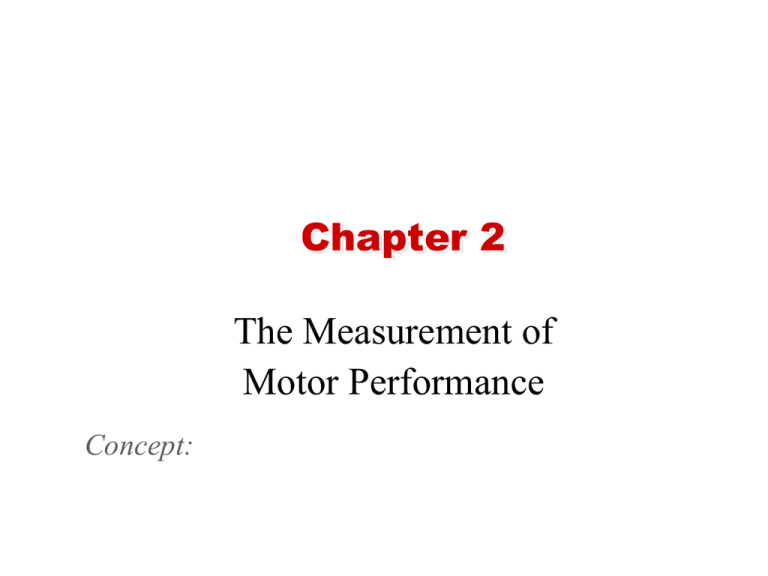
Chapter 2
The Measurement of
Motor Performance
Concept: The measurement of motor performance is
critical to understanding motor learning
©2011 McGraw-Hill Higher Education.
All rights reserved.
Why Study the Measurement of
Motor Performance?
Performance measurement essential for:
____________________________
____________________________
©2011 McGraw-Hill Higher Education.
All rights reserved.
Measuring Motor Skill
Performance
Two General Categories of Performance
Measurements
1. Performance ____________ measures
• Category of motor skill performance that
indicates
____________________________________
____________________________________(
e.g. How far did a person throw the ball?)
• Does not tell us about the behavior of the
limbs or body that led to the outcome
• Does not provide information about the
activity of various muscles involved
©2011 McGraw-Hill Higher Education.
All rights reserved.
Measuring Motor Skill
Performance, cont’d
2. Performance _______________
measures
• Measures of motor skill performance
that indicate
_________________________________
_________________________________
_________________________________
_________________________________
e.g. EMG, EEG recordings
See Table 2.1 for examples of
measures in both categories
©2011 McGraw-Hill Higher Education.
All rights reserved.
Reaction Time
Common measure indicating
_____________________________
_____________________________
_____________________________
A _____________ or go signal is
the indication to act
©2011 McGraw-Hill Higher Education.
All rights reserved.
Events and Time Intervals of
RT and Movement Time
__________
_____
__________
_____
_________
___________
___________
_______
_______
__________
__________
_________
_________
Time
©2011 McGraw-Hill Higher Education.
All rights reserved.
Reaction Time, cont’d
Types of RT situations [See Figure 2.2]
• ______________: One signal - One
response
• ______________: More than one
signal - Each signal has a specific
response
• ______________: More than one
signal - only one response
©2011 McGraw-Hill Higher Education.
All rights reserved.
RT Interval Components
EMG enables us to fractionate RT to
obtain more specific information about
movement preparation
Fractionated RT has two components
• _________________________: Quiet
interval of time between the onset of stimulus
and beginning of activity
• _________________________: Interval of
time from the initial increase in muscle
activity until the actual limb movement
* See diagram on next slide *
©2011 McGraw-Hill Higher Education.
All rights reserved.
Fractionated RT
EMG Recording
_______________
________
________
_______________
____________
____________
_________
_________
What do you think occurs in each RT component?
©2011 McGraw-Hill Higher Education.
All rights reserved.
Error Measures
Error measures allow us to evaluate
performance for skills that have spatial or
temporal accuracy action goals
What are some examples of skills for which
spatial or temporal accuracy determines
performance success?
©2011 McGraw-Hill Higher Education.
All rights reserved.
Assessing Error for Skills with
One-Dimension Accuracy Goals
Three error measures
1. ___________________________:
Absolute value of difference between
the actual performance on each trial and
the criterion for each trial
• AE = |(performance – criterion)| / no. of
trials
• Provides a general index of
performance accuracy
©2011 McGraw-Hill Higher Education.
All rights reserved.
Assessing Error for One-Dimension
Accuracy Goals, cont’d
2. ___________________:Algebraic value
of difference between the actual
performance on each trial and the
criterion for each trial
• CE = (performance – criterion) / no. of
trials
• Provides an index of a tendency for the
performance error to be directionally biased
3. __________________: The standard
deviation of the CE scores; an index of
performance consistency (i.e.
variability)
©2011 McGraw-Hill Higher Education.
All rights reserved.
Assessing Error for One-Dimension
Accuracy Goals, cont’d
See “A Closer Look” on p. 32 for
an example of calculating AE, CE,
and VE to determine the accuracy
characteristics of stride lengths for
walking
©2011 McGraw-Hill Higher Education.
All rights reserved.
Assessing Error for TwoDimension Accuracy Goals
When the outcome of performing a skill
requires accuracy in the
____________________________ directions
• e.g. Golf putt
_____________________= General accuracy
measure for two-dimensions
• See Figure 2.4
_____________________ and
___________are difficult to quantitatively
assess, although can do qualitative assessment
easily
• See Fig. 2.5
©2011 McGraw-Hill Higher Education.
All rights reserved.
Assessing Errors for
Continuous Skills
Many continuous skills require
________________________________
________________________________
• e.g. Driving a car on a highway
________________________________
Common accuracy measure for
continuous skills
• See Fig. 2.6 for example of calculating
RMSE for a pursuit tracking task
©2011 McGraw-Hill Higher Education.
All rights reserved.
Kinematic Measures
_________________: description of motion
without regard to force or mass
Includes the following measures [see Fig. 2.7]:
• _______________=Spatial position of a limb or
joint over a period of time
• _______________ = Rate of change in an object
position with respect to time (i.e. speed)
= Displacement / Time
• _______________= Change in velocity during
movement
= Velocity / Time
©2011 McGraw-Hill Higher Education.
All rights reserved.
Kinetics
__________: Force as a cause of motion
Human movements involve both
external and internal sources of force
Importance of force as a movement
measure: All three Newton’s laws of
motion refer to force
Force measurement:
• _______________
• _______________
©2011 McGraw-Hill Higher Education.
All rights reserved.
EMG Measures
__________________________________
Electrodes detect electrical activity
Electromyography (EMG) =
__________________________________
__________________________________
• Common use is to determine when a muscle
begins and ends activation [see Figure 2.10]
• Also – Recall our earlier discussion about
use of EMG for fractionated RT as an index of
movement preparation
©2011 McGraw-Hill Higher Education.
All rights reserved.
Brain Activity Measures
Researchers have adopted brain activity
measures commonly used in hospitals
and clinics for diagnostic purposes
Three measures commonly reported in
motor learning and control research
• __________
• __________
• __________
©2011 McGraw-Hill Higher Education.
All rights reserved.
Brain Activity Measures, cont’d
Electroencephalography (EEG):
Measures electrical activity in brain
• ____________________________________
_____________________________________
Positron Emission Topography (PET):
Neuroimaging (i.e., brain scanning)
technique that measures blood flow in the
brain
• ____________________________________
_____________________________________
©2011 McGraw-Hill Higher Education.
All rights reserved.
Brain Activity Measures, cont’d
Functional Magnetic Resonance Imaging
(fMRI): Neuroimaging (i.e., brain
scanning)
___________________________________
___________________________________
___________________________________
To see examples of PET, fMRI, and other brain
scanning techniques, go to http://www.pbs.org/
and type “brain scanning” in the Search box
©2011 McGraw-Hill Higher Education.
All rights reserved.
Measuring Coordination
Assessment of the relationship of
movement of limb-segments and
joints
Quantitative measurement of angleangle diagrams
• ______________________________
• ______________________________[
see Figure 2.11]
©2011 McGraw-Hill Higher Education.
All rights reserved.






